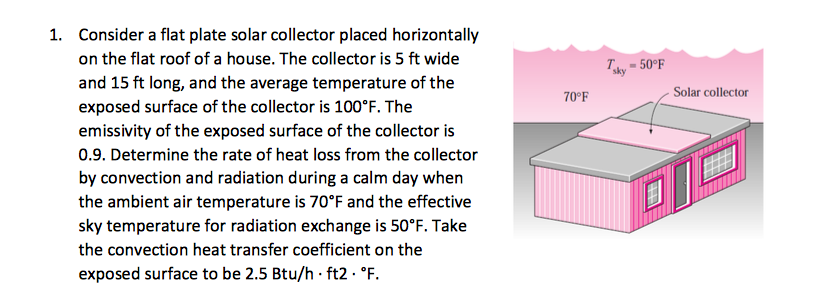1. Consider a flat plate solar collector placed horizontally on the flat roof of a house. The collector is 5 ft wide Ty50°F sky and 15 ft long, and the average temperature of the Solar collector 70°F exposed surface of the collector is 100'F. The emissivity of the exposed surface of the collector is 0.9. Determine the rate of heat loss from the collector by convection and radiation during a calm day when the ambient air temperature is 70°F and the effective sky temperature for radiation exchange is 50°F. Take the convection heat transfer coefficient on the exposed surface to be 2.5 Btu/h ft2. F
1. Consider a flat plate solar collector placed horizontally on the flat roof of a house. The collector is 5 ft wide Ty50°F sky and 15 ft long, and the average temperature of the Solar collector 70°F exposed surface of the collector is 100'F. The emissivity of the exposed surface of the collector is 0.9. Determine the rate of heat loss from the collector by convection and radiation during a calm day when the ambient air temperature is 70°F and the effective sky temperature for radiation exchange is 50°F. Take the convection heat transfer coefficient on the exposed surface to be 2.5 Btu/h ft2. F
Principles of Heat Transfer (Activate Learning with these NEW titles from Engineering!)
8th Edition
ISBN:9781305387102
Author:Kreith, Frank; Manglik, Raj M.
Publisher:Kreith, Frank; Manglik, Raj M.
Chapter6: Forced Convection Over Exterior Surfaces
Section: Chapter Questions
Problem 6.36P
Related questions
Question

Transcribed Image Text:1.
Consider a flat plate solar collector placed horizontally
on the flat roof of a house. The collector is 5 ft wide
Ty50°F
sky
and 15 ft long, and the average temperature of the
Solar collector
70°F
exposed surface of the collector is 100'F. The
emissivity of the exposed surface of the collector is
0.9. Determine the rate of heat loss from the collector
by convection and radiation during a calm day when
the ambient air temperature is 70°F and the effective
sky temperature for radiation exchange is 50°F. Take
the convection heat transfer coefficient on the
exposed surface to be 2.5 Btu/h ft2. F
Expert Solution
This question has been solved!
Explore an expertly crafted, step-by-step solution for a thorough understanding of key concepts.
This is a popular solution!
Trending now
This is a popular solution!
Step by step
Solved in 7 steps with 6 images

Recommended textbooks for you

Principles of Heat Transfer (Activate Learning wi…
Mechanical Engineering
ISBN:
9781305387102
Author:
Kreith, Frank; Manglik, Raj M.
Publisher:
Cengage Learning

Principles of Heat Transfer (Activate Learning wi…
Mechanical Engineering
ISBN:
9781305387102
Author:
Kreith, Frank; Manglik, Raj M.
Publisher:
Cengage Learning